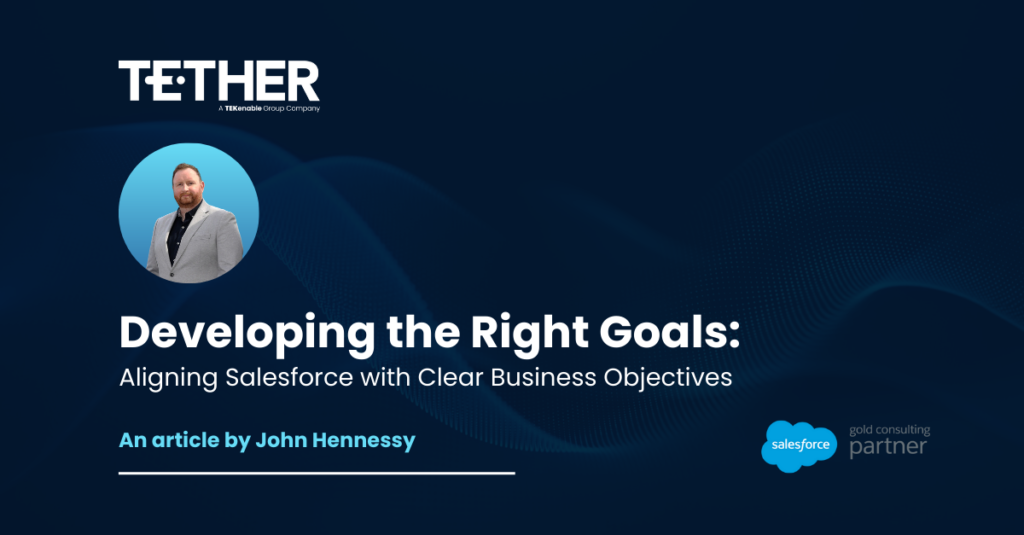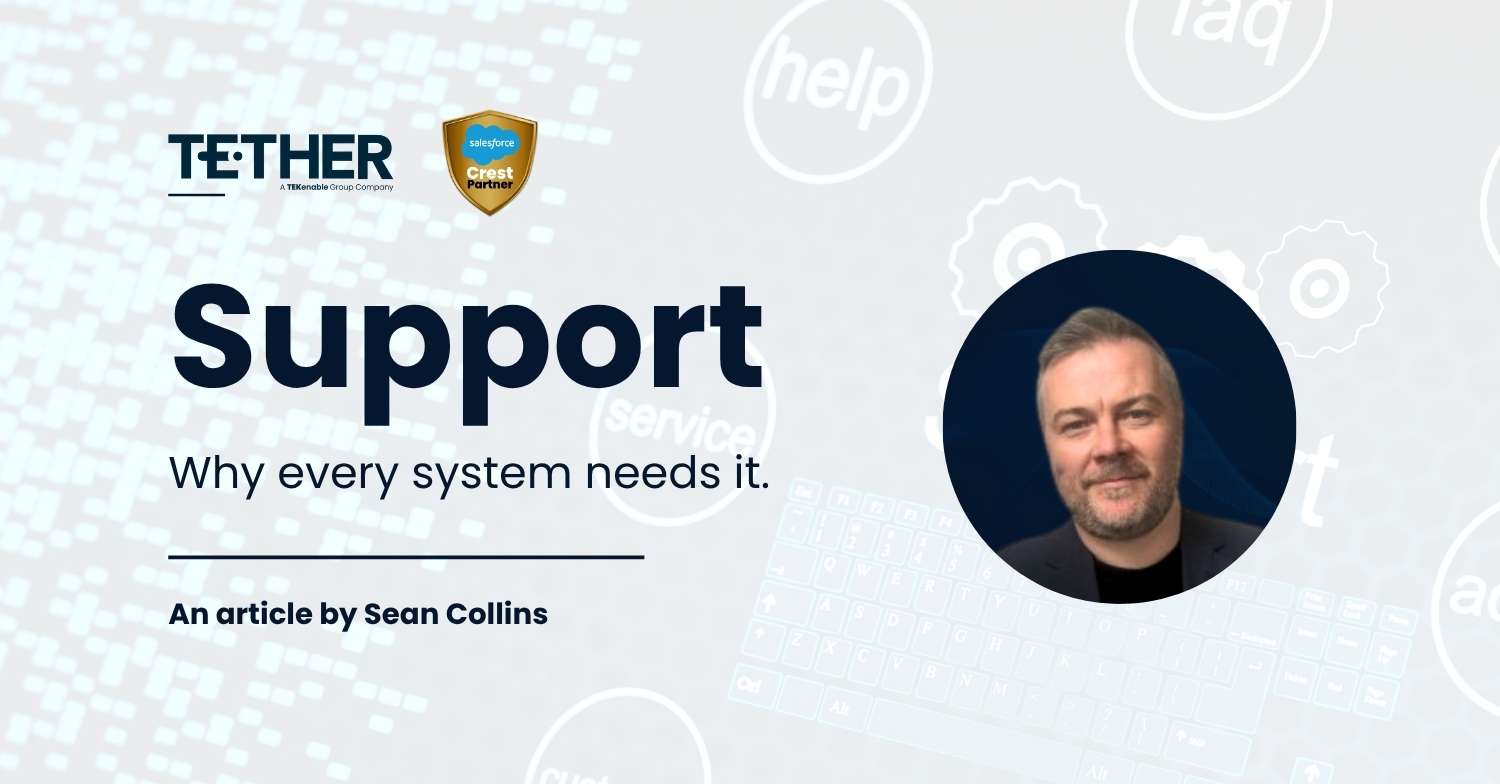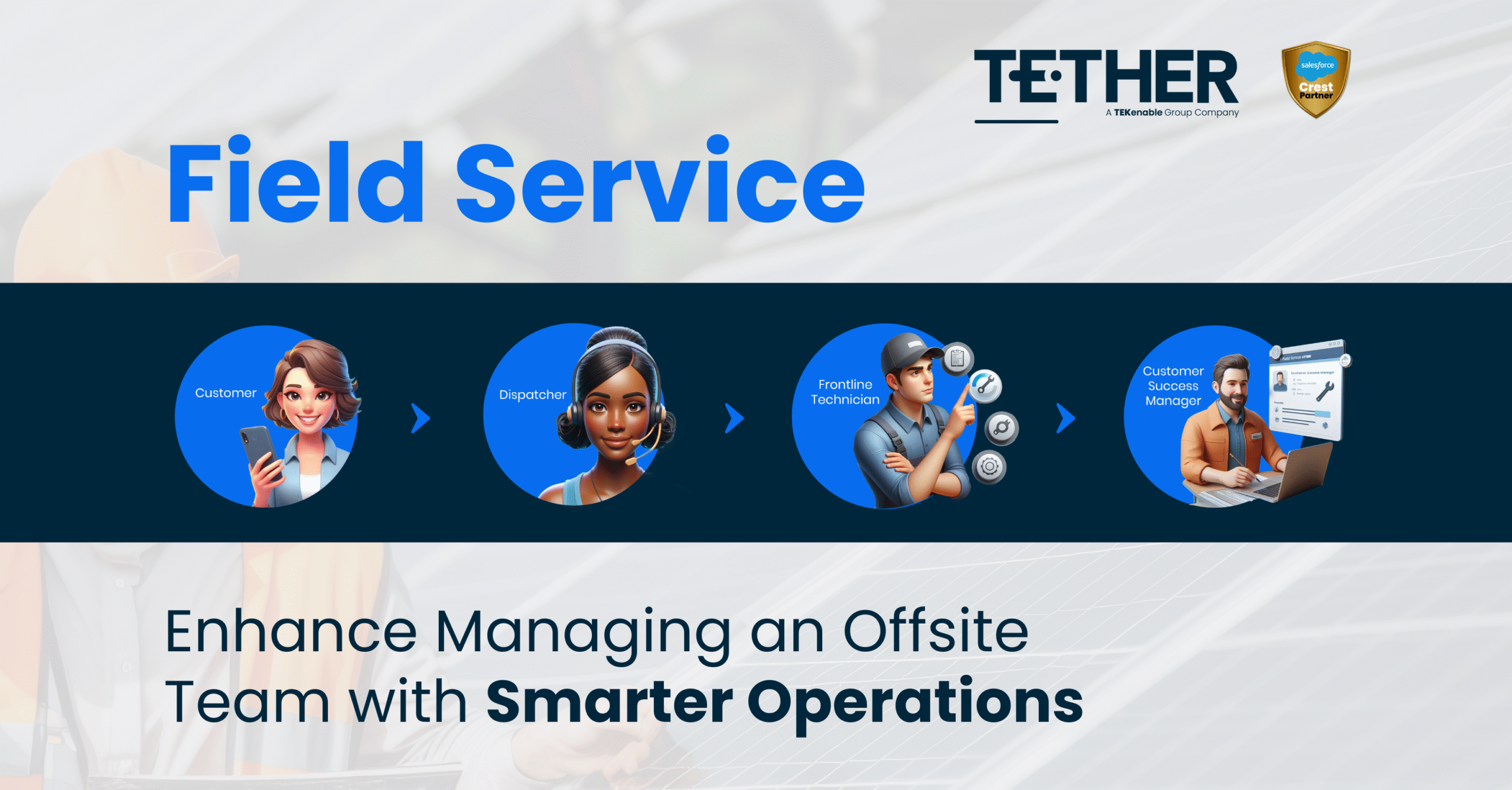Setting clear business goals is a critical step for any organisation aiming to achieve success.
The good news is that embedding goals in everyday processes is not only possible, when the Salesforce platform is properly implemented, it can drive both action and reporting. Any organisation in search of success – which is surely all of them – can align their objectives with actionable strategies, using the platform’s capabilities to track progress and drive results.
It is not a case of one-size-fits-all, though. While every business wants to see improvements in both the bottom and top lines, and every organisation of every sort wants to be as efficient as possible, how they define success and, crucially, how they measure the milestones on the road to success will differ according to industry, sector, size, the market being addressed, and even the nature of the organisation.
At Tether, we know that Salesforce is the right platform for organisations that want to use data (Read more on our previous blog: Becoming a Data-Driven Business Utilising Salesforce) to grow their business and help customers to succeed, but it is essential that the business goals are encapsulated in the right Key Performance Indicators (KPIs) and success metrics, and that the user-interface (UI) is designed to make the right information accessible to the right people at the right time.
Get SMART: identifying key business goals
The first step in achieving business success is identifying key goals. These can range from increasing revenue and improving customer satisfaction to expanding market reach and enhancing operational efficiency. Clearly defined goals provide direction and purpose, guiding decision-making and strategic planning.
For instance, a company might set a goal to increase annual revenue by 15%. Another might aim to boost customer satisfaction scores by 10%. These goals should be specific, measurable, achievable, relevant, and time-bound (SMART).
Once business goals are established, the next step is to transform them into something more tangible by defining KPIs and success metrics. By having measurable values that indicate how effectively a company is achieving its key business objectives, staff will have a clear way to track progress and make informed decisions.
For a company aiming to increase revenue, relevant KPIs might include monthly sales growth, average deal size, and conversion rates. For improving customer satisfaction, KPIs could involve Net Promoter Score (NPS), customer retention rates, and average response time to customer inquiries.
Success metrics are specific measures used to evaluate the success of an initiative. These metrics should be directly tied to the business goals. For example, if the goal is to enhance customer service, a success metric could be reducing the average response time to customer queries by 50%.
Aligning Salesforce with business goals
With that in mind, Salesforce can turbocharge businesses, Driving Velocity and supporting Data-Driven Decision Making.
However, customising Salesforce to align with business goals is crucial for maximising its effectiveness. Salesforce offers a high degree of customisation, allowing businesses to tailor the platform to their specific needs, but unlike the software of the past, customising Salesforce does not leave users out on a limb.
Rather than reworking core code, Salesforce is designed to be modular and customisable while remaining a cloud-based platform that never needs to be refreshed or reinstalled.
Customisations include configuring fields, objects, and workflows to support business processes, as well as creating effective dashboards that ensure users have access to the right information right when they need it.
Most crucial of all is implementing Salesforce dashboards and reports.
Dashboards are powerful tools for visualising KPIs and tracking progress towards business goals, and the right ones will provide real-time insights, enabling decision-makers to monitor performance and identify trends.
To create effective dashboards, it’s important to focus on clarity and relevance. Dashboards should present data in a visually appealing and easily digestible format. Including charts, graphs, and key metrics allows users to quickly grasp important information. For example, a dashboard for sales managers might include graphs showing monthly sales trends, a pie chart of sales by region, and a list of top-performing sales reps.
Reports, meanwhile, are essential for analysing data and generating insights. Salesforce’s reporting capabilities allow organisations to create detailed reports tailored to their specific needs. These reports can be customised to include various data points, filters, and groupings.
Creating and customising reports involves defining the report type, selecting fields, applying filters, and choosing a format (tabular, summary, matrix, or joined).
Regularly reviewing and interpreting report data helps businesses stay on track with their goals and make informed decisions. For instance, a sales report might highlight the number of closed deals, average deal size, and sales cycle length, providing insights into sales performance and areas for improvement.
Seeing what you need to see
In addition, a fully customisable user-interface means that the entire user experience can be created according to user role. This matters because a well-designed UI simplifies navigation and enhances productivity, enabling users to focus on their tasks without getting bogged down by a cumbersome interface.
Best practices for designing an intuitive UI include organising information logically, minimising clutter, and providing easy access to frequently used features. Customisable home pages, streamlined navigation menus, and role-based layouts can help create an efficient UI. For example, a sales rep might have a dashboard displaying their pipeline, upcoming tasks, and recent opportunities, while a customer service agent might see open cases, customer details, and support history.
Finally, internally with an organisation, Salesforce Admins play a vital role in this customisation. They can create custom objects to store unique data, design workflows to automate repetitive tasks, and set up validation rules to ensure data integrity. By tailoring Salesforce to the business’s unique requirements, Admins help ensure that the platform supports the achievement of business goals.
Real-world applications
While Salesforce is the opposite of an unknown quantity, it is worth reflecting on how some of the biggest businesses in the world have used the platform to help them reach their goals.
For example, Adidas used Salesforce to enhance its customer service operations. By integrating Salesforce Service Cloud, Adidas streamlined customer interactions and improved response times, resulting in higher customer satisfaction and loyalty.
Similarly, cloud giant Amazon Web Services (AWS) uses Salesforce to support its sales and marketing efforts. By customising Salesforce to track key metrics, AWS improved efficiency and gained valuable insights into customer behaviour.
There are success stories closer to home, too. Among Tether’s clients are AIA Loss Assessors Limited and Northcott Global Solutions.
Working with Tether AIA, streamlined processes and, crucially, gained invaluable insights into its business that were previously out of reach, enabling it to expand its capabilities.
NGS, meanwhile, was able to drastically reduce the administrative burden on staff by automating processes and minimising redundant tasks, resulting in an enhancement in productivity across all areas of the business.
Software to support the business
Developing the right business goals and aligning Salesforce to support them is a powerful strategy for achieving success. By identifying key goals, establishing KPIs and success metrics, and customising Salesforce to fit business needs, organisations can track progress and make informed decisions. Implementing an intuitive UI and effective dashboards and reports further enhances the platform’s usability and impact.
The journey to becoming a goal-oriented, data-driven organisation requires commitment and continuous improvement. However, with Salesforce as a robust tool, organisations can confidently pursue their objectives and realise their vision for success.
At Tether
We are the experts in Salesforce implementation. In a complex world, we make it simple. Tether bridges the gap, tapping into the full capability of Salesforce to drive your business forward. As a leading Salesforce Partner in the UK, we provide comprehensive Salesforce services to transform how you connect with customers and manage your operations.
Contact us today!




